| |
Close encounters of the VAR kind...
 Just
having got back from an 11-day trip to Denmark to compete for Team GB at the FCI
European Championships, Alan Bray rushed straight on to the Derbyshire Show on
the Sunday and then directly onto the IFCS World Agility Championships at the
Oakridge Arena (Newark) where he was judging, so no peace for the wicked! He
took time from his busy schedule to write this report for Agilitynet. Just
having got back from an 11-day trip to Denmark to compete for Team GB at the FCI
European Championships, Alan Bray rushed straight on to the Derbyshire Show on
the Sunday and then directly onto the IFCS World Agility Championships at the
Oakridge Arena (Newark) where he was judging, so no peace for the wicked! He
took time from his busy schedule to write this report for Agilitynet.
What a lovely
friendly atmosphere and well-run event this was. It's a hidden gem of an
international competition. Eleven countries were there to compete for both
Individual and Team medals over two or three different agility tests including a
Snooker and Gamblers competition and Team Relay event.
Dawn Weaver and Dave
Russell had told me a while ago I was going to 'volunteer' to judge this so, not
knowing much about the event, I set about doing some homework. I quickly
realised I needed the expert help of Rachel Ward who is brilliant at this sort
of thing.
Rachel dug out the
rules and that included for Snooker and Gamblers and looked at previous courses
to get a good feel for what differed between IFCS rules and those for the KC and
FCI which I was already familiar with. John Bowe from Ireland was my co-judge.
He got Snooker which left me with Gamblers to design which I hadn't judged - or
competed in - for at least 100 years now when we still had black and white TVs!
Armed with this
knowledge, I set about designing courses to fit in a 30m wide x 40m long arena
so lots of space to play with. I needed to pitch the level of difficulty right
to ensure that it was a good test for international finals as well as being
entertaining to watch and good for handlers and dogs to work on. I also had to
plan my route around the course so that I could be in position to effectively
judge the contacts, long jump and weaves without being in the handler’s way. As
the late great John Gilbert used to say 'the handler shouldn't even realise the
judge is there, Alan!'
I was allocated
Biathlon Agility on the Wednesday afternoon as the opening class of the event so
needed to get us off to a good start. John did the Snooker on Thursday morning
before I came back in to judge the Triathlon Agility.
VAR in
agility
Now there's a topic. If you haven't
heard of VAR, it's a video replay which is slowed down or frozen and then checked
by going forward
or backwards, frame by frame. It is widely used -
and abused - in Premier League football, but better used in cricket, for
example, when contentious decisions or game changing referee/umpire/judge's
decisions are challenged and then reviewed.
One
of the interesting
differences between
IFCS and other international competitions is that participating countries are allowed to
challenge a judge's decisions on any matter, including contact calls. Queries
are reviewed with the use of VAR cameras, strategically positioned around the
course and then viewed in ultra-slow motion.
There is a time limit so teams can't
come back a day later and challenge them.
At the IFCS World Championships, cameras are placed
around the arena at all up and down contacts points
and/or anywhere there could be
contentious decisions. Countries are allowed up to three
challenges per class. Only Team Managers can come forward with a challenge which
must be written down and presented to the IFCS Chief Judge. If clear and
obvious, they will rule in favour of the class judge's decision but, if it is
debatable, they will call over the judge to discuss the findings in-between dogs running,
like in the
Premier League when referee is called over to the side to study the big screen.
With 11 participating countries, worst case
scenario was there could have been 33 reviews to study and decide in each class.
Just imagine the disruption
and how long it would take to run. Thankfully, this didn't happen, but I have to
admit that my first thought was 'oh
my gosh... there are going to be lots of challenges as a near call is bound to be
challenged.' Happily, it didn't work out that way for me with relatively few calls
being made.
My two wrong calls were for allowing seesaw
contacts when the dog had alighted a micro-second before the plank hit the
floor. Realistically, it was
pretty nigh on impossible to see with the naked eye at full speed and could only could only be
judged with the aid of a frame -by-frame look at the video. I received about six
challenges all
told throughout the week but thankfully all my dog
walk and A-frame calls were proved correct.
In the Team Relay, I did check
myself. I was relieved that I had called the USA team correctly, having
faulted an A-frame when that was their only fault on a very fast run.
Fortunately when I looked at it on the screen, I was spot on, but it was good to
reassure myself. When I came back out and announced to the crowd that I had
double-checked the A-frame contact and it was correct ... so don't bother
challenging it,' this was met with laughter, bless them.
As always when
judging, I gave myself plenty of space to see the contacts. I made sure that I didn't have to look through other
obstacles or have handlers running in front of me to make the call on very fast dogs
doing running contacts. This is something
at experienced judges like John Gilbert and Arthur Rogers taught me when I
first started out judging.
I was very pleased with the outcome of the challenges, being proved right 99.5%
of the time. Only a couple of seesaw calls were corrected on the first day when
I had allowed the seesaw though VAR showed the dog to have just left before the plank
hit the floor. It was very close call and hard to see with the naked eye. I tightened this
up after that and didn't receive another seesaw challenge after that.
My wrong calls
were all on the generous side. I didn't fault a seesaw when I should have
done rather than faulting when the dog actually hit the contact, but then that's
because I am always on the side of the dog and want them to do a nice clear
round.
 I
now work out a judge's path in advance so I am not in the handler's or dog's way or
eye line. I need to be able to see clearly so I can make the correct judging decisions such as
whether they actually went
over the long jump or through the side of it etc. Watch Martin Tait judging
nowadays. He is always in the right spot. I
now work out a judge's path in advance so I am not in the handler's or dog's way or
eye line. I need to be able to see clearly so I can make the correct judging decisions such as
whether they actually went
over the long jump or through the side of it etc. Watch Martin Tait judging
nowadays. He is always in the right spot.
I recall my experiences
judging at
Crufts in 2014 and 2016. Close decisions are usually replayed on the giant,
cube-shaped screen above the course in the main arena before the next dog is
allowed to start. I made a point of not waiting to see the replay. Usually you
can hear the crowd going 'ooh and arrh' anyway. My wife Louise watched from
the Kennel Club VIP seats while I judged. Whenever I looked
over at her, she'd nod her head, indicating that I had got the decision right.
On one course, I remember setting a very fast dog walk jump finish
where the dogs went straight out the tunnel and over the finish. Steve Richardson's
dog looked to have missed the down contact with everyone going 'ahhh.' Although being
on the opposite side to the crowd, I could see the dog's back left toes touching the
contact, so I gave the clear. The gasps when this came up on the cube were very
interesting, and I remember Graham Partridge commentating said, 'That's why we are sat here
and Alan is down there.'
Does VAR happen
anywhere else in dog agility world? The answer is yes. In fact, when Team GB is competing
in the FCI European and World Championships, VAR has already been available to
the judges so they can
review their own decisions. The difference is that other individuals or countries are
not allowed to complain or ask for a VAR
review.
My advice to new judges is to never be afraid to ask
an experienced judges for help and advice. Remember that
they have been there and done that already and most will be more than
happy to help.
You
mustn't let VAR affect you and knock your confidence. You need to embrace it and
see it as a helpful addition to your judging toolbox to ensure that you get the
big decisions right. Be big enough to acknowledge that. On occasion, you get
something wrong. With the speed of dogs over contacts these days, it's
very difficult to get every decision right, so don't beat yourself up for a wrong
call.
But I digress...
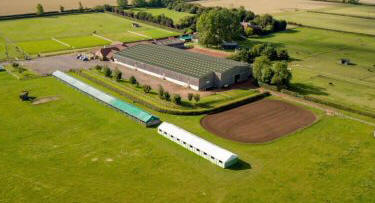 Back on course Back on course
Friday
was afternoon again with the Individual Jumping while John did the morning
shift. Then I doubled back Saturday morning to judge the Gamblers so after
finishing quite late the day before it was a very early 7am start the next
morning. I then finished off Sunday afternoon with the Triathlon Team Relay
which is a bit like Mini-Mixi so I split the course in half with an A-frame and
weave down the middle with the first and third dog running the right-hand side
of the course and the second dog running the left -hand side. Again, slightly
different rules as the handler runs with the baton in their hand and changes
over behind the start and finish line. It does state in the rules however, that
you are not allowed to hit the dog with the baton! Or the judge for that matter,
haha!
Tuesday was for dog
measuring and team practise in the arena then Wednesday morning the remaining
countries practise before the opening ceremony. This was very passionately
delivered by all 11 countries involved including Japan, Canada, USA, Italy,
Belgium, Ireland, Switzerland, Spain, France and the hosts Great Britain
Straight after this
and welcome drinks and cakes for all participants, whilst we built my agility
course. All handlers were given 10 minutes to walk it in their separate groups
and then we were ready to start.
I must say the ring
party crew were fantastic. They all got stuck in helping and nothing was too
much trouble. We ensured the pole pickers weren't in the dog's eye line so
nicely tucked away as was the manual back up timer. A 'first jump goal keeper' was
there to give a visual signal to the handler so once I blew my whistle to start,
they moved out of the way and the handler could go. There was no timed start so
they could go in their own time.
Wednesday - Competition Day 1
First Class
Biathlon Agility
Course length: 194m long
Times: Toy - 69 secs, Mini - 66 secs, Midi and Maxi - 57 secs.
|
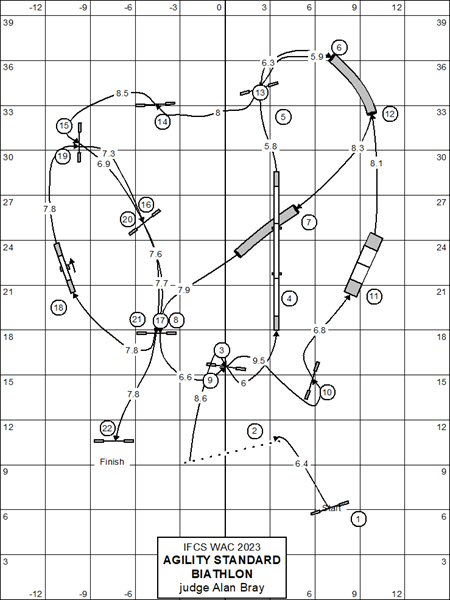 |
This was a
very fast course that needed dogs to have the necessary skill sets at
speed and gave handlers lots of different options to handle so it was a
good one to judge.
Some of the
main issues with the course concerned the weave entry from the start and
dogs taking the back of the finish jump. Some went straight onto the
A-frame from Jump 3 and others straight in tunnel from the dog walk.
The run from
Tunnel 6 to Tunnel 7 caused all sorts of issues with handlers forgetting
their dogs and going straight up the A-frame, while others attempted to
run completely around the dog walk instead of layering it, thus not
getting to Jump 8 in time and resulting in a refusal or an 'E.'
Other
handlers were very excitedly telling their dogs to go-on at Jump 8...
so, of course, they did, straight over the last jump!
The bogie
jumps were numbers 15 and 17. We lost count of how many times these were
knocked down and then dogs running around the last jump.
|
Thursday - Competition Day 2
Triathlon
Agility
Course length: 197m long
Times: Toy - 70 secs, Mini - 67 secs, Midi and Maxi - 58 secs.
|
Competition
Day 2 began with John Bowe judging the Snooker. After a lot of technical
problems, John managed to complete by 15.00 which was two hours later
than scheduled. Please don't ever ask me to judge the Snooker. Having
watched John, I really appreciate how difficult it is to remember
everything. I have no idea how he managed to it.
My
'afternoon' class was another agility one, the Standard Triathlon. By
the time the arena had been harrowed, the course built and the handlers
had walked the course, we didn't start until 17.15 hours.
It was
designed to be a very fast forward going run. Provided the dogs had the
necessary skill sets, it allowed their handlers to take short cuts and
leave them to work away alone. The handler could then meet their dog at
the next section that required handling.
One of the
problems handlers found occurred after the long jump (No. 4) with dogs
overshooting Jump 5. They needed early warning to slightly turn left
after the long jump, then the exit from Tunnel 6. Some dogs weren't
called, and they shot back over Jump 5 and consequently overshot their
weave entry, gaining a 5R.
There were so
many different ways to handle the weaves (No.7) to Jump 10 that it made
it interesting to watch. Many of the dogs had decided on their own way
of doing this from Jump 8 to the tunnel which didn't coincide with the
handler's way.
When dogs
going over Jump 10 weren't called in, they headed for the last jump
instead of No.11. Then again when dogs were not communicated with, they
headed for the start jump instead of the push round blind on Jump 12 to
line the A-frame up.
From the
running A-frame, handlers had the option to layer the weaves and meet
their dog coming over Jump 17 or, if they enjoyed running, then going
the whole way around the weaves with their dog.
Then the
seesaw! This caused huge amounts of problems with dogs alighting too
early as the handler was under pressure to get the threadle over Jump
21. This could be done with a slice for the fastest time or a wrap which
was slower. Alternatively, they could run the other side of Jump 20 and
do a German turn over Jump 21 or indeed a whisky slice.
It was such
good fun to judge, and the crowd seemed to really enjoy it too with lots
of cheers going on. We finished around 20.00 hours so not bad really
given the 17.15 start time and having to reset the weaves after the
Mallies had destroyed them.
Once again, I
must say that my ring party was excellent. Thanks very much for working
such a long day. |
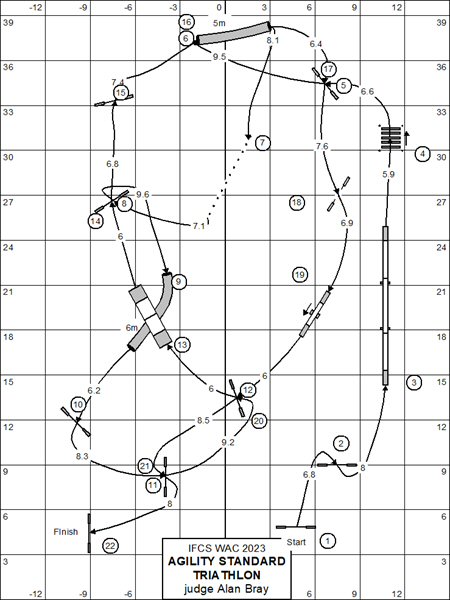
|
Friday - Competition Day 3
Individual All Around Jumping
Course length:- 184m long
Times: Toy - 51 secs, Mini - 46 secs, Midi and Maxi - 41 secs.
|
 |
On Friday, it
just poured down. We were swamped outside in the car park and in the
camping area. Trust the good old British weather, eh!
Thanks Dawn
Weaver for reminding me that I was judging in England when I could have
been asked to go to sunny Spain or Italy. Typical. The forecast was for
rain all weekend as well – what joy!
John judged
the Agility in the morning and then I did the Individual All Around
Jumping class in the afternoon. Don't ask... I don't understand what it
means either.
Then
we held the presentations from all the previous evenings which were held
over because of the late finishes the day before.
My Jumping
class was designed for skill sets at speed and the ability to work dogs
away from the handler with push arounds all being natural lines for the
dogs so no clunky around the back moves.
The spread,
set at just below maximum, caused all sorts of problems with many dogs
having it down except the Toy/Small height class.
I also
noticed many of the dogs had the spread down in John's classes, too as
well so looks like a training refresh coming up for many of them.
Handlers had
many different ways in which to work this course, and it was good to
watch the variety of handling options and routes taken.
|
Saturday - Competition Day 4
Gamblers Individual and All Around
Course times: Toy - 35 secs, Mini - 46 secs. Midi and Maxi - 33 secs.
Gamble times - Jump 1 to over Jump 6: Maxi and Midi - 14 secs. Mini and Toy - 16
secs.
|
This was so
difficult to plan for but thankfully Rachel Ward had done some great
work on rules and had some previous courses for me to look at which made
things a lot easier. It was a hundred years ago when I last judged a
Kennel Club Gamblers, but some of the rules were different for the IFCS
version so I had to look at this one the most of all the course designs.
IFCS has an
opening section where you can do obstacles a maximum of twice but not in
succession. You couldn't do contact to contact either. This section can
also include a 'Joker' sequence where you score bonus points for
completing a section or specific obstacles in the section before
attempting the Gamble. The Gamble must be an at distance challenge where
the handler cannot cross a line at least 5m away from the dog whereas,
in KC terms, we would allow them to go closer, but they wouldn't score
maximum points so it was similar but just removed the crossing the line
option.
Handlers had
to do the Gamble obstacle No.1 at before going over the Finish jump.
Otherwise, they were eliminated. If their dog ran out of the arena at
the end before doing the last jump, they were also eliminated. In
addition, if handlers did two or more of the Gamble obstacles in the
first section, they were E'd.
My
original plan was to number the obstacles in the opening section. I
expected to be able to call out points to my scrime from my microphone,
only to find out that that none of the obstacles in the opening section
would be numbered. So, I had to call out the number of points for each
obstacle and the scrime would add these up at the end. Only the Gamble
obstacles were numbered.
Still with
me? Being ancient, I thought I would never remember it all. If the
handler did the same obstacle, I decided to score it one point for
Jumps, three for tunnels, five for the A-frame and seesaw and seven for
the dog walk and weaves and allow the jumps to be done as many times as
they like so I didn't have to remember if they had done two or more.
They loved this option!
I then added
in the three tunnels as the Joker in any direction, scoring 10 bonus
points in the opening sequence. The Gamble was marked by the line of
four jumps which handlers weren't allowed to go pass. The Gamble scored
15 points so they needed to do this really to get maximum points.
My aim was to
create a flowing course in the first section which the handlers could
just flow around and allow a natural finish which went straight into the
Gamble section. Handlers are not allowed to stand and wait for the
Gamble as that's an elimination as well. The course also provided enough
for those not as confident about contacts to do a jumping and tunnels
and weaves course.
I planned my
own route around the course so that I could stay between the A-frame and
dog walk in order to see the seesaw and weaves and stay out of the way
of handlers who chose many different routes, making it more interesting
to watch rather than everyone going the same way around.
Most problems
of the Gamble section were caused by handlers not being near enough to
start so they were out of time for the 40m run to the end! I
deliberately designed it to be along the audience seating area so they
were all cheering dogs along the finish. Also, handlers then standing
around the Tunnel 2 exit where the jump marking the line was - so the
dogs targeted them stood there instead of the long jump and, of course,
just dogs not wanting to work away from the handler, but there were many
brilliant runs here with everyone cheering those who made the gamble.
We endured
lots of technical problems during the class but managed to resolve them
all and get it done. Big thanks to Paul Moore for coming out of
retirement and timing for me as it was vital the hooter sounded spot on
time for the Gamble section to start. Well done to the Irish Team who
were brilliant on this together with Team GB. |
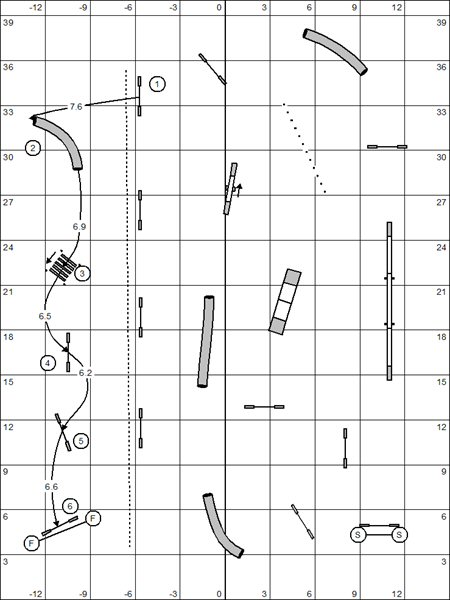
|
Sunday - Competition Day 5
Team Relay
Triathlon
|
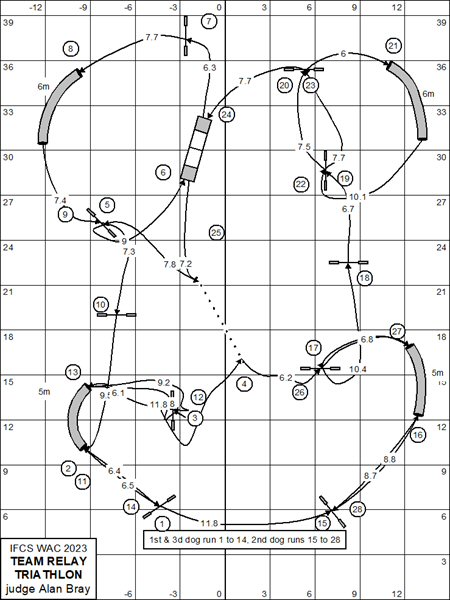 |
Here it
was... the last day. It seemed a long week for everyone competing
especially with the great English summer weather of very heavy rain and
mud and then very warm sunshine.
The Team
Relay consisted of three dogs and handlers with two different heights
allowed in the team and a maximum and minimum number of obstacles to
negotiate with a baton change in-between each partnership.
I designed
this like a KC Mini/Mixi Pairs course with two dogs of the same height
going out on the left side of the course and the other height on the
right side, so the jump heights don't get mixed up. Both sides then do
the centre section including A-frame and seesaw.
Handlers have
to run with the baton in hand and then pass to the second handler who
runs with it unlike the KC where the baton staying behind the line. If
the baton was dropped, it would be an elimination.
Then the way
this ran was that each team would run as they were drawn irrespective of
height so no grouping together of say all Maxi and Midi heights or Toy
and Mini heights. It meant we changed the jump heights after every team
had run which seems strange to me but we had ring party positioned at
each jump ready to change heights after every team had run and we got
through it okay although I had to make sure the heights were right
before allowing the next team to start.
You know
anything can happen with Teams. This was no different with two dogs on
the course at the same time. Three partnerships were all clear right up
until the last but one obstacle when the French girl forgot to go back
into tunnel 13 from jump 12 and went straight over the finish, running
through with her arms aloft believing they were all clear but getting
the team eliminated. The poor girl was so upset, crying on the floor
because it meant so much to them all. No words made it any easier for
her.
There were
some brilliant runs and clears and some so close and others where
everything that could go wrong – did!
Thoroughly
enjoyed judging this one. It was great fun. |
Afterwards we held
the awards and closing ceremony and speeches which was a great event. Then got
packed up and drove home.
Thank you to Dawn
Weaver for inviting and trusting me to judge and to Wim Bekendam, the IFCS chief
judge, for all his help in understanding the rules and regulations and course
design guidance helping to tweak things on the day.
Huge thank you to the
ring party and team who were brilliant all week and to fellow judge John Bowe
and Kate Smith expert commentating.
 About
the author... About
the author...
Alan Bray
has vast experience both in judging and competing at international level.
Currently he is a member of the successful Team GB which competed at the FCI
European Championships in Denmark in mid-July 2023, and he is off to compete in
the World Cup in Czech Republic in early October so he was ideally suited to
know the standard of course designs to pitch.
Over his 33-year
agility career, he has won every domestic honour and major final several times
as well as a major final with different dogs and different breeds and even
heights. In addition, he has made five different dogs up to Agility Champions.
As the owner of
Upanova Tigers, he has helped train others to achieve success at the highest
level by continuing to evolve training and handling methods and styles to
suit current course tests.
Alan
keeps his feet firmly on the floor though, saying that he is lucky to have so
many good friends in agility and to able to spend quality time with
his lovely wife Louise and daughter Selena - both at training and shows.
First published 3rd
October 2023
| |
|